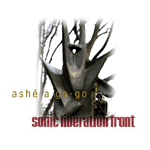|
|
 |
Dusted Reviews
Artist: Sonic Liberation Front Album: Ashé A Go Go Label: High Two Review date: Jan. 7, 2005 |

|
|
|
 |
In lieu of a better excuse, one can point to the allegorical relationship of Sonic Liberation Front’s Ashé A Go Go as an example of the tumultuousness of American culture and politics and posit that it’s no crime to visit critical analysis upon this work at the beginning of 2005, a solid 6 months after its original release. Perhaps only now can this nation, and, unfortunately, all nations, begin to form a clear perspective on the last half of a year that has claimed so much psychic energy, so many lives, and so many chances at different, if not better, futures. Ashé A Go Go emerged on the crest of a moment in time during which a domineering minority pulled the wool over the eyes of the poor and the underrepresented, using barrels of cash and ill-gotten influence over the courts and state governments to forward a largely theological agenda, imposing it upon the silenced voices of the true majority, wrapped in the insult that the clergy of this value system are the same robber-barons and influence-peddlers that high-jacked it in the first place.
Sonic Liberation Front, a tight collective of mostly Philly-based musicians centered around percussionist and composer Kevin Diehl, continues the grand experiment of their first album (Water and Stone) with a thesis as bold as the group’s name, though Ashé A Go Go does so with a subtlety and elegance that might escape the passive or casual listener. The sound of the SLF is not the reinvention of the jazz or occasional soul that informs the constant overtone, the reachable lid to the melting pot that lies underneath. In fact, the sounds that bubble beneath, steeped in ages of Afro-Cuban and Yoruba cultures and their respective rhythms, constitute a snapshot of substantial progress for traditions that were meant to die in the “new world.” The roots of Afro-Cuban religion and its music arrived in the Caribbean undercover – kidnapped Africans feigned assimilation to the Catholic culture of their assailants, their deities (or orishas, as they are known in Nigeria, Cuba, and the many other countries in which the Nigerian religion Ifa is practiced) sincretized with and disguised as Catholic saints.
There is no disguising the rhythms of Afro-Cuban religion; the meter of nearly all Afro-Latin music, whether sacred or profane, is clave, instantly recognizable whether it’s played with a pair of wooden sticks or programmed using the canned rim shot of a 606 drum machine. On Ashé A Go Go, Diehl the composer (he also holds the sole producer credit; whether he wants to be or not, Diehl is the frontrunner for “visionary” of the group) incorporates both traditional rhythms and instrumentation – bata drums played by Diehl and the group’s other principal percussionist, Chuckie Joseph, as well as the guiro style that incorporates conga, cowbell, and three shekeres – and angular brass arrangements, with equal debts to Ornette Coleman, Joe Maneri, and even latter-day skronkticioners like Ken Vandermark. For a few moments, songs like “The Sirens” even recall “Footsteps” and cool-era Miles Davis. While several of these arrangements find their own way and sound fresh, the groundbreaking occurs in Diehl & Co.’s reworking of the African component. It’s one thing to arrange the choruses of Afro-Cuban spiritual music with more “Western” harmonies, but to do so in contrast with the decidedly modern horn charts, as the group does on the title track, results in the album’s most dissonant moments, and turns the meaning of the music on it’s ear. Songs and rhythm of Afro-Cuban music are traditionally performed with a singular goal and purpose: to bring the orisha into the room and mount some of the worshippers present. Toying with the harmonies and the instrumentation is tantamount to swapping elements and integers in chemistry. Diehl either doesn’t know what fate he’s tempting, or something in him has led him to believe that there are permeable borders around the temple. Evidence for the latter abounds, with Diehl’s collaborators lending their tacit approval.
One of those collaborators, and reason enough to know and learn this piece of work, is bassist Andy Gonzalez. Gonzalez represents a pinnacle of scholarship, history, and dedication to all things Afro-Cuban. Having toyed with the formula 35 years ago as a sideman for Eddie Palmieri, the seminal Grupo Folklorico y Experimental NeuvoYorquino, and as a founder of Libre, Gonzalez has eaten, composted and grown from seedling every form of Afro-Cuban music known to the masses since his involvement as a teenager in the Bronx. With Gonzalez now spending a decent part of his waking hours in a wheelchair (due to the loss of toes to his progressing diabetes,) Sonic Liberation Front secures legitimacy for not just the album – which features more “out” playing by Gonzalez that more traditional outings, like his work with the Fania All-Stars and Chico O’Farrill’s big band, have rarely afforded him – but for the experiment itself.
Moments where SLF doesn’t always win so decidedly include Diehl and Joseph’s complete overhaul of “Agua Dulce,” set to folksy guitar strumming, and a chorus that is recorded dry and overbearingly, but the frequency and depth of these moments dissolve over repeated listenings. However disingenuous it may seem to compare the theft of Africans from their homes 400 years ago to the ideological siege of the NeoCons that duped the Plains states in their entirety, Ashé A Go Go is the quiet, prescient soundtrack of redemption. The defeated will now disguise their values and dreams as those of the newly reelected goon regime, and with Diehl’s blueprint for how to tweak the forbidden traditions of common people and sharpen the tools of culture, revolution will someday soon emerge from the hulls of society with new songs, fashioned from old ones, ready to thump and crack the decks above.
By Andy Freivogel
|







